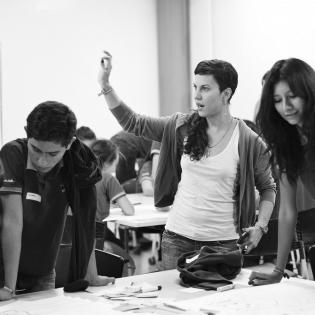What Is Philanthropy? A Call to Action
Inspired by stories of service, young people define philanthropy concepts and actions. They brainstorm acts of kindness and determine how they will contribute to the common good.
The learner will:
- describe the characteristics of a philanthropist.
- brainstorm acts of kindness and giving.
- stories of “Giraffe Heroes” (people who stick their heads out for the common good) from The Giraffe Heroes Project found at www.giraffe.org Look in their database for stories of youth projects.
- Learning to Give's Open Doors to Your Community resources introduce youth to the nonprofits in their community.
Read about the service-learning project called Let the Reading Begin by Indiana students who were taught using this What Is Philanthropy? A Call to Action lesson to guide student learning and action.
Young people write about their giving in a paragraph or poem. They tell about the need they addressed, the action they took, and the impact on themselves.
- www.giraffe.org, “Profiles of Giraffe Heroes”
Instructions
Anticipatory Set:
Write the word philanthropy on a chart or board. Talk about the definition as “giving one’s time, talent or treasure and taking action for the sake of another, or for the common good.” Time and talent may include using your voice or connections to make positive change.
Define common good (interests of all) and ask the learners to think of actions they took that put the interests of all above their own (being quiet in the library, wearing a mask to stop the spread of infection, or showing respect for an opposing team). Guide a discussion about the meaning of "taking action for the common good" as doing service that shows care for others.
Give groups time to explore the Giraffe Heroes website and choose a story of service they want to examine. Ask the groups to read their stories and discuss the following:
- What is the philanthropic act?
- How did it help the common good?
- What opportunity for themself did the philanthropist give up in order to act (opportunity cost)?
- What are some traits of the philanthropist (generous, creative, selfless...)?
As a group, brainstorm a list of actions they can take as philanthropists. Start with a discussion about things they like about their community and things they would like to see changed (This Blue Sky Activity facilitates envisioning a better situation). They may propose ways to volunteer time, share their talent, advocate for a cause, or donate treasure to address a need.
Explore the nonprofits in the community that address the needs they identified. Learning to Give's Open Doors to Your Community resources introduce youth to the nonprofits in their community.
Guide the young people to collectively select a service project they can do and make a plan to carry it out. The projects can range in scope and time commitment. Help them plan for each component of the project, including investigating the issue and resources, deciding responsibilities for the plan, and taking action. Reflect regularly as they carry out the plan.
Philanthropy Framework
-
Strand PHIL.I Definitions of Philanthropy
-
Standard DP 01. Define Philanthropy
-
Benchmark MS.1 Define philanthropy as individuals and organizations providing their time, talent, and/or treasures intended for the common good throughout history and around the world. Give examples.
-
Benchmark MS.4 Give examples of how individuals have helped others.
-
-
-
Strand PHIL.II Philanthropy and Civil Society
-
Standard PCS 01. Self, citizenship, and society
-
Benchmark MS.4 Describe the characteristics of someone who helps others.
-
-
-
Strand PHIL.III Philanthropy and the Individual
-
Standard PI 01. Reasons for Individual Philanthropy
-
Benchmark MS.4 Identify and describe the actions of how citizens act for the common good.
-
-
